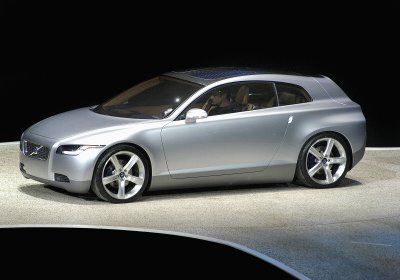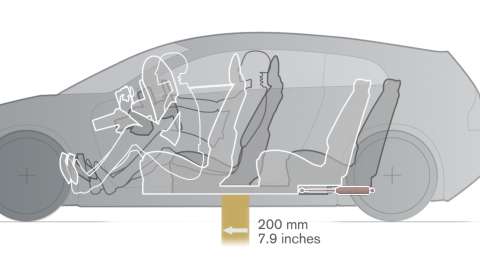 A Remarkable Improvement in Small Car Impact Safety – Volvo's Safety Ride Down Concept |
 A Remarkable Improvement in Small Car Impact Safety – Volvo's Safety Ride Down Concept |
 The Volvo 3CC concept was unveiled at the 2005 Detroit Motor Show |
|
21st January, 2005 The 3CC concept car is remarkably small. Yet beyond the 3CC's ability to comfortably seat three adults or two adults and two children, the concept embodies a revolutionary safety system which promises to improve the frontal impact protection of small cars. Volvo Car calls this unique safety solution the Safety Ride Down Concept. Volvo is convinced that the car will continue to maintain an important role in the future. Man’s dependence on the car for freedom of movement and lifestyle independence is unassailable. However, global environmental demands will promote smaller and more energy-efficient cars without compromising impact safety. As cars grow smaller, Volvo Car is well on the way to ensuring that occupants of small cars are transported safely. The Volvo Monitoring and Concept Centre (VMCC) in Camarillo, California, has tried to make some sense of this big-car-safe-car equation by looking at impact safety from a new angle. A small car simply doesn't realise the luxury of size as a safety advantage. VMCC had to do more with less. The result is the Volvo 3CC concept, a sporty and appealing, extremely aerodynamic and compact car equipped with an energy-efficient electric motor. “The brief was to develop a car for the future,” says Lex Kerssemakers, Senior Vice President, Brand, Business and Product Strategy at the Volvo Car Corporation. “The car of the future is environmentally efficient and one that also takes up little space on the road. It also has to be comfortable, enjoyable to drive, attractive to look at and, not least, safe to ride in. We simply had to adopt an entirely new approach.”
While working on the 3CC, Volvo’s engineers struggled with the issue of slowing down and absorbing incoming collision forces in a frontal impact in the shortest possible crush zone. A small car with a short front has very limited space for deformation. At the same time, the occupants’ forward motion must be controlled as gently as possible. The occupant's deceleration is the sum of the car’s deceleration and the ride-down in the interior restraint systems. In a small car, such as the 3CC, the car’s deformation is limited by its physical size. To compensate for this, an increase in the interior ride-down length is necessary. It is possible with this approach to provide a similar level of soft stop for the occupant despite the limited deformation (crush zone) available. The Safety Ride Down Concept is a more advanced system following the same principles used in the design of, for example, a conventional collapsible steering column or load limiting seat belts. To explain, the unique Volvo Safety Ride Down Concept is a seat system that moves forward during a frontal impact, a bit like a sled, at the same time as the front is deformed. The seat system's movement is slowed with the help of adaptive shock absorbers that tailor the damping effect to suit the collision force and the occupants’ number and weight. The interior can move between zero and 200mm forward, which has the same overall effect as extending the crumple zone by a corresponding length. All seats move forward What is more, the steering wheel and a movable dash panel move forward as well to create space for the driver’s movement. The sliding components are unlocked and the dampers activated in the event of a crash severe enough to deploy the airbags. The seats slide forward/rearward on guide-tracks. The system is also extended for rear impact in allowing the seats to translate rearward by 75mm, which reduces the impact forces on the occupants. The moving interior is also utilised to aid entry to the rear seat. All it takes is to press a button on the door pillar and all seats slide forward. “The Volvo Safety Ride Down Concept has been tested in a virtual environment for more than three years,” says Kolita Mendis, Structures and Safety Engineering Manager at VMCC. “The tests give us a pretty good picture of the forces we’re up against and how best to handle them.” He adds, “The Volvo Safety Ride Down Concept has appeared from time to time as an interior safety concept proposal in one form or another for more than 40 years. Our virtual testing has showed that the most important part of a ride-down system is the energy absorber, and that it needs to be adaptive to be a viable concept, by responding to differences in occupant load and crash severity.” The dampers are based on the same technology as those found in adaptive shock absorbers that were introduced in Volvo’s advanced R-models car in 2003. Prototype dampers have been further developed in cooperation with two Swedish universities, the Chalmers University of Technology and Luleå University. The dampers are hydraulic and operate electronically. These dampers can be adjusted every two milliseconds. The impulses can come from a number of sensors that read such parameters as vehicle and seat deceleration, as well as inputs from the occupant restraint system. “The Volvo Safety Ride Down Concept is a promising stage in our protective safety development,” says Ingrid Skogsmo, Director Volvo Cars Safety. “We’ve learned a lot in the process. The next step could be to continue developing technologies from the concept stage.” |
 |
